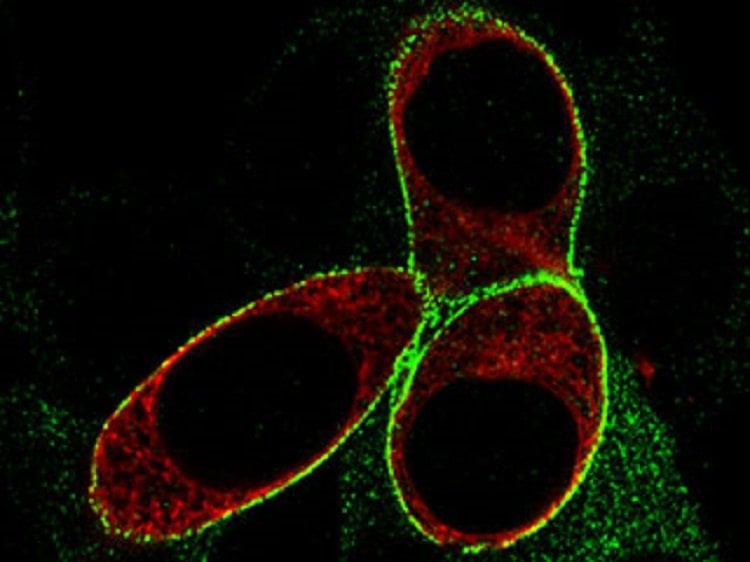A new class of drugs under development to treat depression has shown some success by targeting brain cells’ ability to respond to the chemical messenger glutamate. But the mechanism by which these experimental therapies work has remained unknown. The recent discovery, by a Rockefeller University-led team, of a molecular amplification system helps explain how the drugs alter brain signaling in particular neurons, and so produce an antidepressant effect.
The results, published September 15 in Molecular Psychiatry, center on a signal receptor known as mGluR5 found on neurons.
“Our experiments suggest that mGluR5 amplifies the cellular response to a chemical signal, and that by blocking mGlur5 receptors in inhibitory neurons involved in depression, these new therapies can achieve an antidepressant effect,” says senior author Paul Greengard, Vincent Astor Professor and head of the Laboratory of Molecular and Cellular Neuroscience. “Since mGluR5 is considered a target for treating a variety of neurological disorders, including Parkinson’s disease and Fragile X Syndrome, our research may have implications for therapies for diseases beyond depression.”
The path to mGluR5 began with the molecule p11. In 2006, Greengard’s lab and their colleagues linked decreased levels of p11, which increases neurons’ sensitivity to the chemical message serotonin, to depression. This discovery helped to explain how selective serotonin reuptake inhibitor (SSRI) antidepressants work and has made it possible to improve upon them.
Now the research team, led by first author Ko-Woon Lee, a research associate in the lab, wanted to see if p11 had a similar effect on a different signaling system within the brain. Because it is among the receptors targeted by the new class of antidepressants, they focused on mGluR5, which responds to a number of chemical signals.
In the brain, p11 and mGluR5 are both found in cells that produce glutamate as well as those that manufacture a competing signal, GABA. Glutamate signals prompt activity in neurons, while GABA has the opposite effect, tamping it down. Imbalances between the two have been implicated in psychiatric disorders, including depression.
After establishing that p11 interacts with mGluR5 and controls signaling by the receptor, the researchers deleted p11 or mGluR5 in both GABA- and glutamate-producing cells. They assessed the effects using behavioral tests, including putting food in the middle of an open space and timing the animals’ response.

The results showed opposite roles for the molecules in the excitatory versus inhibitory neurons. The loss of mGluR5 or p11 appeared to dampen the GABA neurons’ signaling, as shown by the mice’s increased willingness to pick up food pellets from an open field — a proxy measure for resilience from depression and anxiety. Meanwhile deletion of p11 or mGluR5 in glutamate neurons produced mice hesitant to retrieve the food, a sign of a depression-like state.
GABA- and glutamate-producing neurons can work in tandem, with a particular class of GABA neurons tamping down excitatory glutamate signaling. This is the secret to the new mGluR5-blocking drugs, the researchers found. In experiments, one such drug inhibited these GABA neurons, thus allowing for an increase in activity among the glutamate neurons, and, as a result, producing an antidepressant effect in the mice.
“This study in combination with prior work shows that the same molecule, p11, mediates the actions of two distinct classes of antidepressants in two totally different types of cells within the brain,” says co-corresponding author Yong Kim, a research assistant professor in the lab.
“We think that its partner in this case, mGluR5, may also play a role of previously unrecognized breadth, acting within many different types of cells to intensify signals, such as those transmitted by GABA, glutamate, or other neurotransmitters,” Kim adds. “This suggests a mechanism by which drugs that target certain other neurological diseases may be effective.”
Source: Wynne Parry – Rockefeller University
Image Credit: The image is credited to the researchers/Rockefeller University
Original Research: Abstract for “Alteration by p11 of mGluR5 localization regulates depression-like behaviors” by K-W Lee, L Westin, J Kim, J C Chang, Y-S Oh, B Amreen, J Gresack, M Flajolet, D Kim, A Aperia, Y Kim and P Greengard in Molecular Psychiatry. Published online September 15 2015 doi:10.1038/mp.2015.132
Abstract
Alteration by p11 of mGluR5 localization regulates depression-like behaviors
Mood disorders and antidepressant therapy involve alterations of monoaminergic and glutamatergic transmission. The protein S100A10 (p11) was identified as a regulator of serotonin receptors, and it has been implicated in the etiology of depression and in mediating the antidepressant actions of selective serotonin reuptake inhibitors. Here we report that p11 can also regulate depression-like behaviors via regulation of a glutamatergic receptor in mice. p11 directly binds to the cytoplasmic tail of metabotropic glutamate receptor 5 (mGluR5). p11 and mGluR5 mutually facilitate their accumulation at the plasma membrane, and p11 increases cell surface availability of the receptor. Whereas p11 overexpression potentiates mGluR5 agonist-induced calcium responses, overexpression of mGluR5 mutant, which does not interact with p11, diminishes the calcium responses in cultured cells. Knockout of mGluR5 or p11 specifically in glutamatergic neurons in mice causes depression-like behaviors. Conversely, knockout of mGluR5 or p11 in GABAergic neurons causes antidepressant-like behaviors. Inhibition of mGluR5 with an antagonist, 2-methyl-6-(phenylethynyl)pyridine (MPEP), induces antidepressant-like behaviors in a p11-dependent manner. Notably, the antidepressant-like action of MPEP is mediated by parvalbumin-positive GABAergic interneurons, resulting in a decrease of inhibitory neuronal firing with a resultant increase of excitatory neuronal firing. These results identify a molecular and cellular basis by which mGluR5 antagonism achieves its antidepressant-like activity.
“Alteration by p11 of mGluR5 localization regulates depression-like behaviors” by K-W Lee, L Westin, J Kim, J C Chang, Y-S Oh, B Amreen, J Gresack, M Flajolet, D Kim, A Aperia, Y Kim and P Greengard in Molecular Psychiatry. Published online September 15 2015 doi:10.1038/mp.2015.132






